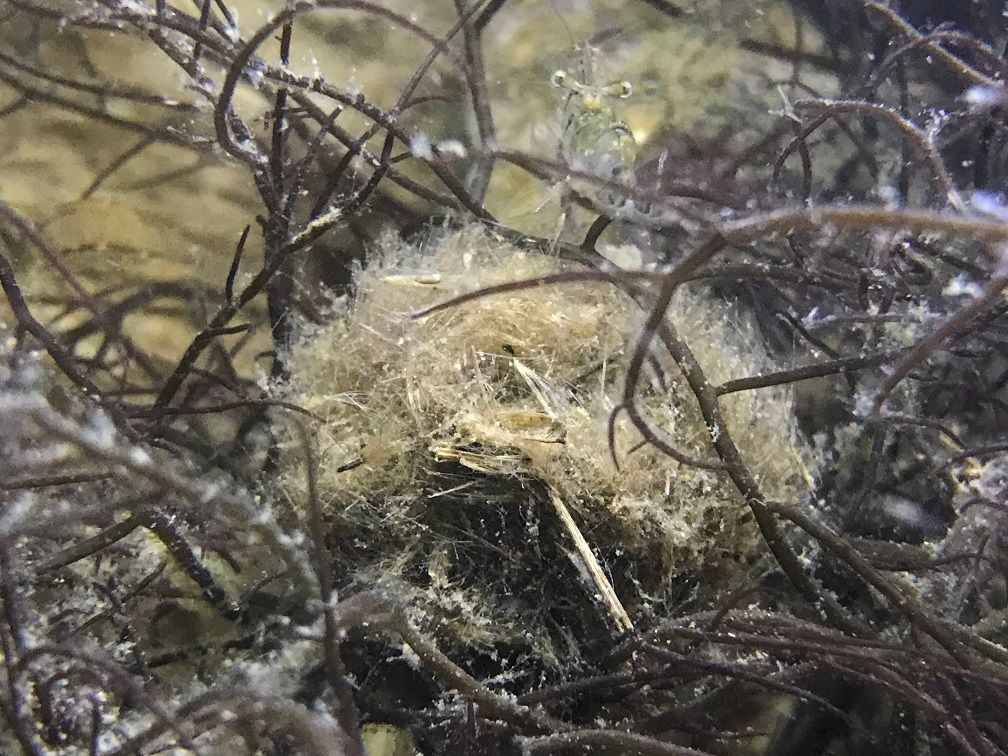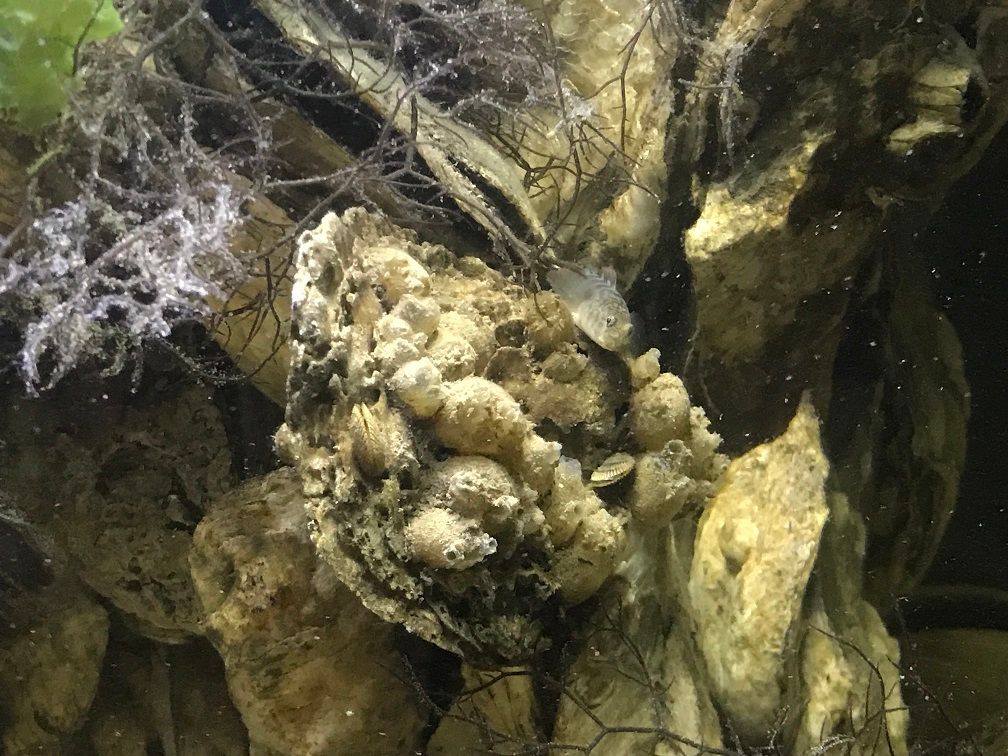
Brackish 20 Long Chesapeake Bay Aquarium
#81

Posted 15 November 2017 - 08:43 AM
Kevin Wilson
#83

Posted 20 November 2017 - 11:11 AM
Update:
The 20g long cyano problem has been reduced to a minimal amount by cutting back the lighted period to 3 hours per day, darkness the rest (not total blackout though). The tank looks a lot better. I went collecting on Saturday, and we caught everything except for pipefish and blennies. The water temperature on the Bay was 49 degrees, so those species probably already headed out to deep water. I added a couple colonies of tunicates to the tank along with another attempt at growing Ulva. I also tossed the old red macro algae for some healthier specimens. The old was holding it's own, but the new brought a few amphipods to the tank. I added a couple live razor clams to the 20g high along with some tunicates.
Regarding the tunicates, razor clams, and mussels (a.k.a. sea squirts or sea grapes), I'm hoping that they'll help with the detritus, but I may have to purchase some food for filter feeders to keep the alive long term. Again, this is an experiment. What works well will continue into practice and what doesn't will be a lessoned learned idea left in the past.
Here's a full tank shot video:
A little closer in, focusing on the largest cultch:
Kevin Wilson
#84

Posted 20 November 2017 - 11:26 AM
This video is a close up of one of the tunicate colonies. That's all they do, siphon, blow out waste now and then, and contract when fish touch them. Still, I think they're cool and really enhance the aquascaping, giving more of the appearance of a living oyster reef. I will do whatever I can to keep them alive long term. I will try feeding them over the counter planktonic food for now.
Kevin Wilson
#86

Posted 21 November 2017 - 08:20 AM
Thanks NotCousteau!
Here are some pictures of the 20g long for those looking for updates and don't have time for videos. I have a couple more videos that I'll post later today. I have to do some work on them first.
Full Tank Shot:

Two colonies of tunicates (sea squirts):

A couple blennies surrounding a patch of green hair algae:

A pair of grass shrimp:

A tunicate that found its way into an empty oyster shell. It was attached to the red macroalgae (gracilaria sp.?) in the foreground. I have no idea how it wound up in the oyster shell. My hunch is that either a fish or mud crab moved it there, probably the former.

A close up of the tunicate colony:

If you zoom in on the center of the above pic, on one of the tunicates is an encrusting bryozoan colony. I can't tell if it is alive or not. I don't see tentacles, so maybe not. I hope it's alive though, that would be really cool. If it isn't, it is still encouraging because these tunicates probably spent their entire lives at this location, so the chances of me finding more live bryozoans are pretty good. I'm optimistic.

Kevin Wilson
#87

Posted 21 November 2017 - 08:41 AM
I finished with the last two videos. Hope you like them. Sorry for them being shaky at times. I was using a tripod and sometimes when you re-position the camera, the tripod sticks even though I loosened everything. I need to find another way to do it.
In this video, you can see a live barnacle at the 50 second mark:
I kept the camera focused on the largest cultch in the area where the blennies are the most active. It is fun to watch them pop in and out of their hidey holes.
Thanks for watching and checking out my thread. I hope you like the videos. I watch them every chance that I get when I'm away from my tank!
Kevin Wilson
#90

Posted 28 November 2017 - 08:59 AM
Update: I purchased some bottled phytoplankton to feed the barnacle, tunicates and mussels that are in both tanks. The bottle directions state that it is concentrated and you only need to add one capful per 50 gallons twice per week. Since I have a good many filter feeding organisms, I'm going to do this three times per week and see how it goes. I may have to look into culturing my own. I also purchased some ChemiClean to eradicate the cyanobacteria, but haven't applied it yet. The longer dark periods seem to keep it at bay. I don't care too much if I see a little of it, but it was getting nasty and taking over the tank. I have this product in my back pocket if I need it.
Rather than ramble on, I figured I'd post some more Chesapeake Bay Brackish eye candy...In the 20g long, I moved a shell with tunicates and a couple mussels on one side of it up and wedged it tightly to the right cultch. I think it looks great, plus, it's easier to observe them. This goby found it to be his favorite hang out:

Here's a view of the cultch with the new addition:

Full Tank Shot:

A few blenny pics:



Can't forget the skilletfish:


I thought that this was a tunicate, and until I inspect it closer, it could still be one covered with unknown material or organisms. But, it occurred to me that it could be a stickleback nest. We did catch one stickleback during that last collecting trip. That fish currently resides in QT at the Glen Echo Park Aquarium:

And guess what showed up in my 20g high tank of death? I was excited to find new life! I believe this to be the ghost anemone, Diadumene leucolena:

Kevin Wilson
#91

Posted 29 November 2017 - 12:50 PM
Kevin Wilson
#93

Posted 29 November 2017 - 01:47 PM
Thanks Nick. Yeah, I hope you are right about that too. I can't find any info about them in aquaria. However, there is a little info about a closely related species, the orange striped anemone (D. linneata), a non-native species that also occurs in the bay, and they don't seem to have the same impact on the aquarium as aiptasia do. I hope that is the case. The good thing is that the anemone sits in the tank that I'll be running fallow over the winter, so if I need to get rid of them, I can do so without harming my display tank. That said, they might show up in my display. I have no idea when this one actually made it into my tank.
Kevin Wilson
#95

Posted 30 November 2017 - 08:26 AM
Thanks Matt! When I found those songs on there, I couldn't resist not using them ![]()
Nick, as far as the anemone goes, the aquarist at the Glen Echo Park Aquarium (GEPA) says that they have them in one of their tanks and don't seem to be a problem with overpopulation. However, the impact that they may have on the fish species in my tank (or similar sized ones) is unknown, because that tank houses a stingray and a summer flounder. So, I guess I might be one of the first to document their value to an aquarium (at least on web forums).
Kevin Wilson
#96

Posted 06 December 2017 - 09:48 AM
Kevin Wilson
#97

Posted 07 December 2017 - 08:29 AM
I have some pics to share from last night. I will have videos later but still need to process them. But for now...
Skilletfish clinging to the oyster cultch:

Tunicates above, goby below:

Naked goby sitting atop a shell with tunicates and live mussels:

A photogenic striped blenny:

Grass shrimp feeding off detritus over some tunicates:

In the 20g high, a cluster of mussels feeding on a phytoplankton meal:

Also in the 20g high, a ghost anemone awaiting its next meal:

Kevin Wilson
#98

Posted 07 December 2017 - 12:22 PM
Can't explain why, but Kevin's Chesapeake oyster tank is so much more fascinating to me than those tropical "reef tanks" with "Fruit Loop Zoas" and "Strawberry Shortcake Acropora" that many other people get so enamored with. Part of it is of course his descriptions and stories of the inhabitants, but even when i'm just looking at his pictures they grab my attention so much more than rainbow-colored high-end reef tanks.
Gerald Pottern
-----------------------
Hangin' on the Neuse
"Taxonomy is the diaper used to organize the mess of evolution into discrete packages" - M.Sandel
#99

Posted 07 December 2017 - 03:55 PM
Thank you Gerald! My tank is "dirty" compared to theirs, just like the Chesapeake Bay, LOL. Their reefs are so pristine and sterile. I'm shooting for a true biotope, plus, I hate cleaning! Seriously, I do export detritus now and then during water changes.
As promised, videos from last night.
This first video shows grass shrimp eating an unknown organism or object. I've wondered if it is a tunicate covered in other fouling organisms or a discarded stickleback nest (we did catch a stickleback the day that I brought this home, thinking it was a tunicate). It is kind of globby in texture. At one point, I thought that I observed a siphon, but now I'm not so sure. The grass shrimp has been devouring the attached material though. I've never seen a stickleback nest, so perhaps if anyone has seen one, they could let me know if this might be one or not. Thanks.
This next video is not exciting, but I find it interesting. It's a bunch of tunicates and a couple live mussels (opened and feeding, I guess). Around the 5 second mark, one of the tunicates ejects something from its siphon. Is it one of their tadpole larvae? I lost track of it in my tank when the current got ahold of it. I didn't observe any movement from it trying to get to a settling spot, but wouldn't that be cool?
Kevin Wilson
#100

Posted 07 December 2017 - 03:56 PM
The next video is interesting as a blenny is foraging, checking out every nook and cranny around the macroalgae. But, around the middle of the video, decides to enter an oyster shell at about the same time a skilletfish enters, and a brief but harmless battle ensues:
The last video is basically the same spot where several blennies decide to hang out and watch my camera watching them...the three amigos!
Kevin Wilson
Reply to this topic
0 user(s) are reading this topic
0 members, 0 guests, 0 anonymous users








